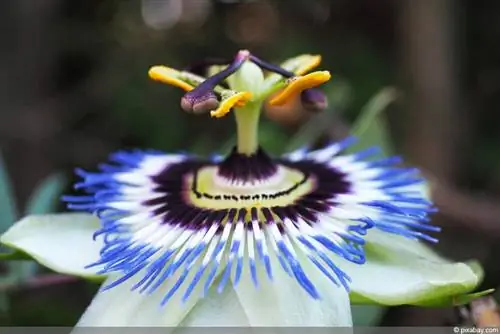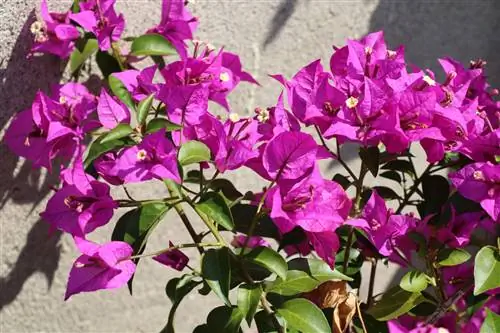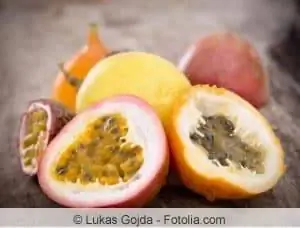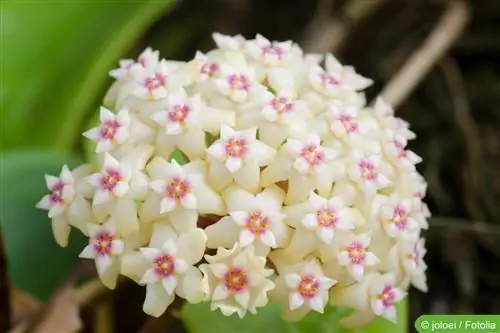- Author admin [email protected].
- Public 2023-12-17 03:39.
- Last modified 2025-06-01 06:48.
Passiflora caerulea belongs to a genus of plants with over 500 species. Since the blue passion flower comes from the tropical and subtropical regions of America, it is only partially hardy. However, if the location has the right conditions, it can be cultivated outside all year round. However, good winter protection is important. In cooler areas, the exotic flower needs suitable winter quarters.
Passiflora caerulea - passion flower
Passiflora caerulea is also known as the blue passionflower and rewards the gardener with a spectacular sea of flowers if the site conditions are right. In a region with a mild climate, it can also be cultivated outside all year round. However, it should be a microclimate in which there are no temperatures below zero in winter. Otherwise, the Passiflora caerulea will only suffer unnecessarily and can even die completely due to extremely cold temperatures. With the right winter protection, the blue passionflower can also be planted in cooler regions. It is important to have enough space, as Passiflora caerulea tends to grow sprawlingly and can quickly overgrow entire areas.
- Shrub-like climbing plant, can grow up to 10 m long and high
- It also grows and blooms in these latitudes
- Ideal locations are wine-growing regions and the Rhineland
- Doesn't need a lot of light though
- Grows better in light-flooded partial shade
- Blooming occurs during the spring, either in April or May
- Peak of flowering is in summer and early autumn
- Forms blue-white flowers about 10 cm in size
- Shows lots of flowers in late autumn in the mild climate
- Sheds the leaves completely in winter, tendrils dry up
- Dropped foliage can be used as winter protection
Winter hardiness
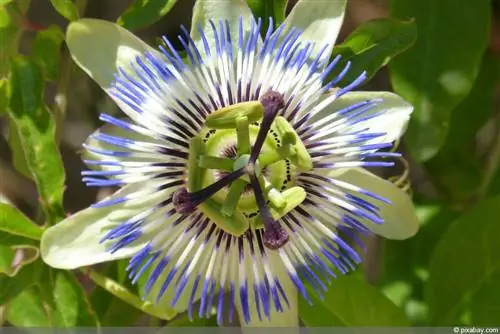
The passion flower (Passiflora caerulea) originally comes from climate zones where temperatures can drop below freezing during the winter months. That's why the blue passionflower is partially hardy and can overwinter outside under certain conditions. However, planting Passiflora caerulea is only possible in areas with a mild climate. Loamy, loose and nutrient-rich soil qualities sustainably improve winter hardiness, as do protected locations in front of walls and on house walls. In high mountain areas and regions with extremely icy winters and a lot of snowfall, the flower needs a winter quarters during the cold season.
- Especially hardy in milder regions
- On average, temperatures in winter must not be colder than approx. -7° C
- Withstands short-term temperatures down to approx. -15° C
- Locations protected from wind and weather are ideal
- Optimally suitable for cultivation as a container plant
- Feels comfortable all year round in sunny, warm winter gardens
Winter protection
Although Passiflora caerulea is hardy, it needs additional winter protection in order to overwinter in the garden. This is especially necessary in the first few years of life to protect the sensitive young plant against cold temperatures. If the blue passionflower is in a location exposed to drafts, special protection is necessary. This not only insulates the heat, but also keeps excess rain and snow away from the plant.
- Place protection from fir brushwood over the roots
- Alternatively, apply a layer of mulch made from leaves or straw
- Aim for a thick layer, but lay it loosely
- If necessary, use cold protection fleece for colder temperatures
- Protect from strong drafts with spruce branches
- Water only on frost-free days
Winter quarters

The plant prepares for winter as early as October. If the blue passionflower is kept as a potted plant in colder regions, it should be placed in a protected winter quarters from November at the latest. Ideally, the plant can get used to the new environment in its winter quarters without too much difference in temperature. However, the temperature values during overwintering should not be too high, otherwise the plant will not be able to adapt properly to hibernation. In this case, there is a risk that the blue passion flower will sprout again. The heated living room is not the right place for this; unheated guest rooms and hallways are better. At the beginning of spring, the Passiflora caerulea should be slowly woken up from hibernation. Be sure to proceed carefully so as not to damage the sensitive plant.
- Pruning plants in autumn
- Bring it indoors in cold areas
- Moving will take place as soon as the temperature falls permanently below 10° C
- Wintering in a frost-free and bright room
- Cool temperatures are ideal, between 5 to 12° C
- Do not fertilize during winter rest
- Water only a little but regularly
- Root ball must not dry out completely
- From March, slowly get used to the external location again
- Be careful with the sun and late frosts
- Do not place the plant directly in the midday sun
- During later frosty nights bring it in again
Tip:
The harder the autumn pruning is, the darker the room can be for overwintering.

